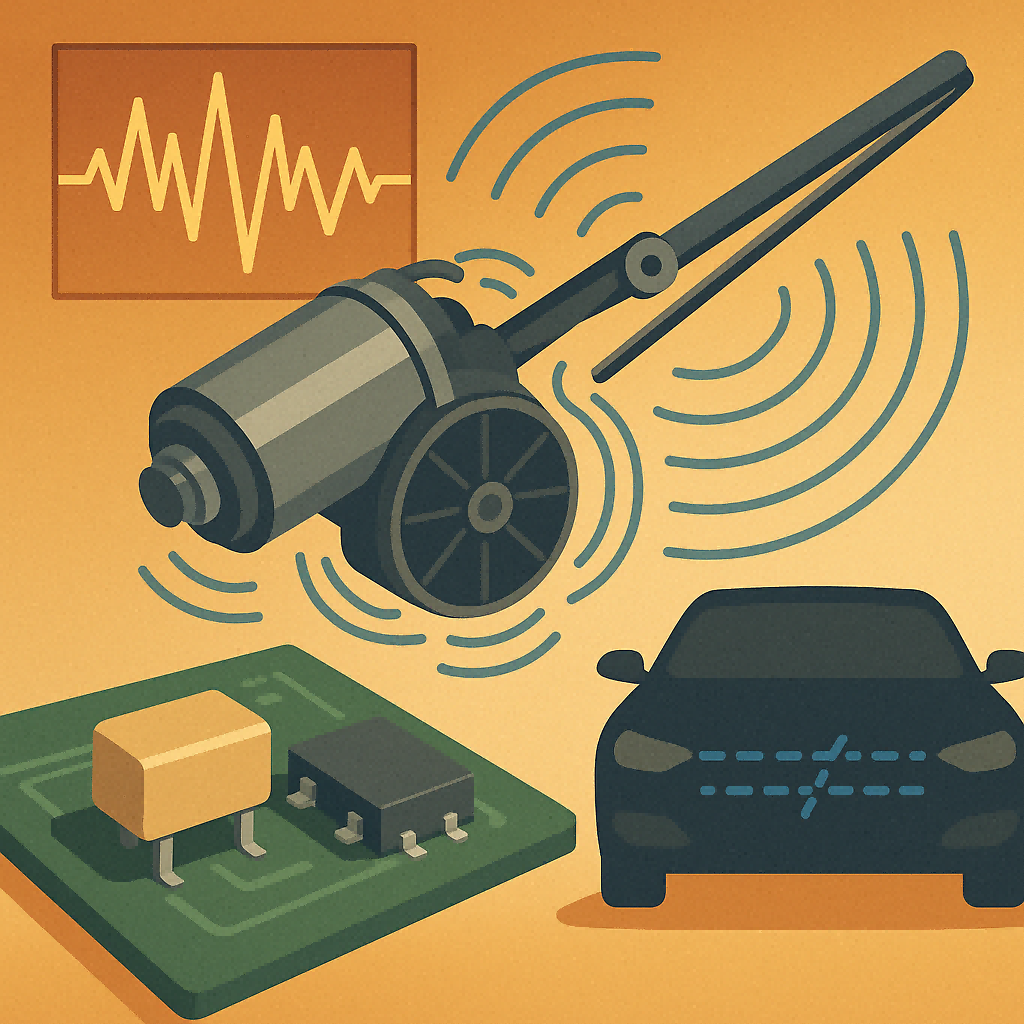Explore how Jaron’s JRN integrated EMI + Surge devices helped Chengdu Huachuan Automotive reduce residual voltage by 37%, improve ISO 7637-2 compliance, and shorten validation time by 67%.

Chengdu Huachuan Electric is a well-known domestic Tier-1 supplier of automotive parts, providing window lifts, wipers, and body control systems to numerous OEMs. Its wiper motor platform, based on a 12V DC power supply architecture, requires a compact structure and high response speed. However, the EMC testing phase became a critical bottleneck causing project delays.
In ISO 7637-2 testing, the customer discovered:
Conducted Voltage Method (Level 3) surge residual voltage exceeded the limit;
Current Injection Method (Level 4) exhibited transient reverse interference;
EMI noise peaks were excessively high during motor commutation, causing interference with the controller's CAN signal.
They initially used a combination of RC absorber and TVS diode, but the problems persisted: the TVS clamping was not low enough, the RC absorption decayed significantly with temperature changes, and verification required multiple rounds of retesting, with an average cycle of up to 6 weeks.
Huachuan's engineering team observed two main problems during testing:
Commutation peak voltage reached as high as 80V. When the wiper motor switched directions in high-speed mode, the instantaneous back EMF exceeded the system's tolerance limit, causing the controller to reset.
High-frequency EMI spectral density exceeded limits. The superposition of carbon brush commutation and PWM speed regulation created broadband noise, exceeding the CISPR 25 limit in the 10–200MHz range.
While traditional RC/TVS networks can partially reduce peaks, they cannot simultaneously address both broadband interference and low clamping requirements.
This is precisely the technological window through which Jaron intervened.
Jaron's engineering team proposed a combined solution for this project using JRN16B105MXG (1µF, 16VDC, 800A) and JRN16B475MXG (4.7µF, 16VDC, 1200A).
The two devices are used for the motor brush and controller power supply, respectively, to construct a "dual-node integrated suppression architecture".
① Sub-25ns response time for rapid surge suppression;
② µF-level capacity for enhanced low-frequency filtering;
③ Ceramic-varistor composite layer ensures low residual voltage stability;
④ Compatible with existing PCB packages, eliminating the need for rewiring.
The hybrid ceramic-MOV structure ensured low residual voltage (<45V) and broadband noise suppression, without layout modification. This plug-and-play replacement simplified the validation process.
The tests were conducted using ISO 7637-2 Conducted Voltage Method Level 3 and Current Method Level 4.
The following are the test comparison results:
|
Test Project |
Traditional RC+TVS solution |
JRN Integrated Solution |
Improvement range |
|
Peak residual pressure |
72V |
45V |
↓37.5% |
|
EMI peak (30MHz) |
−32 dBµV |
−46 dBµV |
↓14 dB |
|
PCB usage |
100% |
42% |
↓58% |
|
Verification cycle |
6 weeks |
2 weeks |
↓67% |
|
Consistency deviation |
±8% |
±2% |
Stable improvement |
Results Analysis: At both 25°C and 85°C, the JRN scheme maintained stable clamping with a smooth residual voltage waveform and no secondary bounce.
After 50 consecutive pulses, the device showed no degradation, demonstrating excellent thermal stability.
Huachuan's engineering team provided feedback during the prototype phase:
"The integrated solution allowed us to pass all tests in one go. Previously, we had to repeatedly modify parameters; now, no debugging is needed."
During the mass production phase, the customer reported:
Each motor module had 3 fewer components;
The cost per BOM decreased by approximately $0.12;
Validation time was reduced by 40 hours;
The EMC test pass rate increased to 98.5%.
① EMC integrated devices are suitable for multi-motor applications such as wipers, window lifters, seats, and tailgates.
② µF-level capacitance is particularly critical for low-frequency suppression, significantly reducing commutation noise.
③ Closed placement near the interference source is crucial for success; the shorter the path, the more efficient the suppression.
④ Closed-loop testing: PSpice model + ISO scripts shorten the verification cycle.
This case represents a structural shift in automotive electronics design from "multi-device stacking" to "functional integration."
The JRN series, with its low clamping, high response, and wideband rejection characteristics, not only solves verification challenges but also promotes supply chain standardization, helping customers quickly adopt global platforms under both ISO and CISPR standards.
Jaron’s integrated JRN solution demonstrates a clear leap in automotive EMC design—fewer parts, faster validation, lower cost, and higher consistency.
It delivers measurable benefits for motor system reliability and sets a benchmark for next-generation automotive electronics.
Wiper Motor EMC | Chengdu Huachuan | JRN Series | ISO 7637-2 Compliance | Automotive Electronics